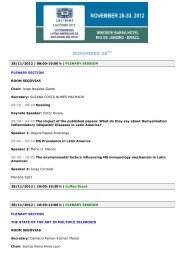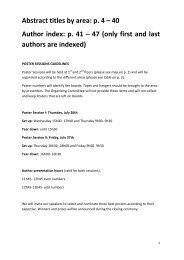Keynote Conference - Interevent
Keynote Conference - Interevent
Keynote Conference - Interevent
Create successful ePaper yourself
Turn your PDF publications into a flip-book with our unique Google optimized e-Paper software.
Symp#6 Membrane Biology<br />
Chair José Garcia Abreu<br />
New Inhibitory Wnt/β-catenin Mechanisms Affecting Embryonic Head Formation<br />
Jose Garcia Abreu, PhD.<br />
Instituto de Ciencias Biomédicas – Universidade Federal do Rio Janeiro. Rio de Janeiro – Brazil.<br />
The establishment of vertebrate embryonic axes involves a series of cellular and molecular events right after<br />
fertilization. In the frog embryo the dorsal ventral axis relies on accumulation of dorsal beta-catenin which together<br />
with Nieuwkoop center set the dorsal organizer, also known as Spemann Organizer. Upon the onset of gastrulation a<br />
number of secreted factors act dorsally preventing dorsal fate from ventral signals. At the same time cells from the<br />
prechordal plate endomesoderm secrete inhibitors of ventro-lateral Wnt signals setting up the antero-posterior axis.<br />
Therefore, Wnt/beta-catenin signaling plays major role in the establishment and patterning of embryonic axis. Here,<br />
we present a new Wnt-beta-catenin inhibitor, expressed in the Spemann Organizer which is essential for proper head<br />
formation. We also present data on how cholestero-rich membrane microdomains interfere with the morphogentic<br />
fields in the head organizer, the pre-chordal plate.<br />
Support: FAPERJ, CNPQ and CAPES.<br />
Membrane Dynamics and Mechanics of Signaling: Role of Caveolae<br />
Sinha, B., D. Koster, R. Ruez, P. Gonnord, M. Bastiani, D. Abankwa, R.V. Stan, G. Butler-Browne, B. Vedie, L. Johannes,<br />
N. Morone, R.G. Parton, G. Raposo, P. Sens, C. Lamaze, and P. Nassoy. 2011. Cells respond to mechanical stress by<br />
rapid disassembly of caveolae. Cell. 144:402-13.<br />
Nassoy, P., and Christophe Lamaze. Stressing caveolae new role in cell mechanics. Trends Cell Biol. in press<br />
Institut Curie, Paris, France<br />
The functions of caveolae, the characteristic plasma membrane invaginations, has long remained debated. The<br />
particular abundance of caveolae in endothelial and muscle cells cells, which respectively experience shear stress and<br />
stretching, led us to investigate the role of caveolae in membrane-mediated mechanical response. Acute mechanical<br />
stress induced by osmotic swelling or by uniaxial stretching results in a rapid disappearance of caveolae, in a reduced<br />
caveolin/Cavin1 interaction, and in an increase of free caveolins at the plasma membrane. Tether-pulling force<br />
measurements in cells and in plasma membrane spheres demonstrate that caveola flattening and disassembly is the<br />
primary actin- and ATP-independent cell response that buffers membrane tension surges during mechanical stress.<br />
Conversely, stress release leads to complete caveola reassembly in an actin- and ATP-dependent process. We further<br />
show that mechanosensing through caveolae in endothelial cells involves the Jak/Stat signaling pathway. Caveolae are<br />
therefore mechanosensors and mechanotransducers which constitute a physiological membrane reservoir that quickly<br />
accommodates sudden and acute mechanical stresses.<br />
Studying Spatial Control of Exocytosis at the Nanoscale in Living Cells<br />
Derek Toomre<br />
Yale University School of Medicine, USA<br />
Cells spatially control exocytosis to control a range of biological function – from cell division, migration, invasion and<br />
the formation of specialized structures such as the primary cilium. Loss of this spatial-temporal control can lead to<br />
diseases including cancer, diabetes, and polycystic kidney disease. This seminar will focus firstly on new superresolution<br />
‘nanoscopes’ and their power to visualize subcellular processes with incredible detail. I will then show how<br />
it to query and even optogenetically manipulate the very last steps of exocystosis, vesicle tethering and fusion. As case<br />
studies, I will show how this approach has given new insight and lead to new concept in cytokinesis, cell migration, and<br />
insulin-mediated trafficking of Glut4 in adipocytes. For examples, in adipocytes we see two membrane trafficking<br />
pathways to the surface and a regulation by insulin on the expansion of the fusion pore. Challenges and potentials of<br />
these new nanoscopes, with special emphasis to membrane traffic, will be discussed.<br />
58





